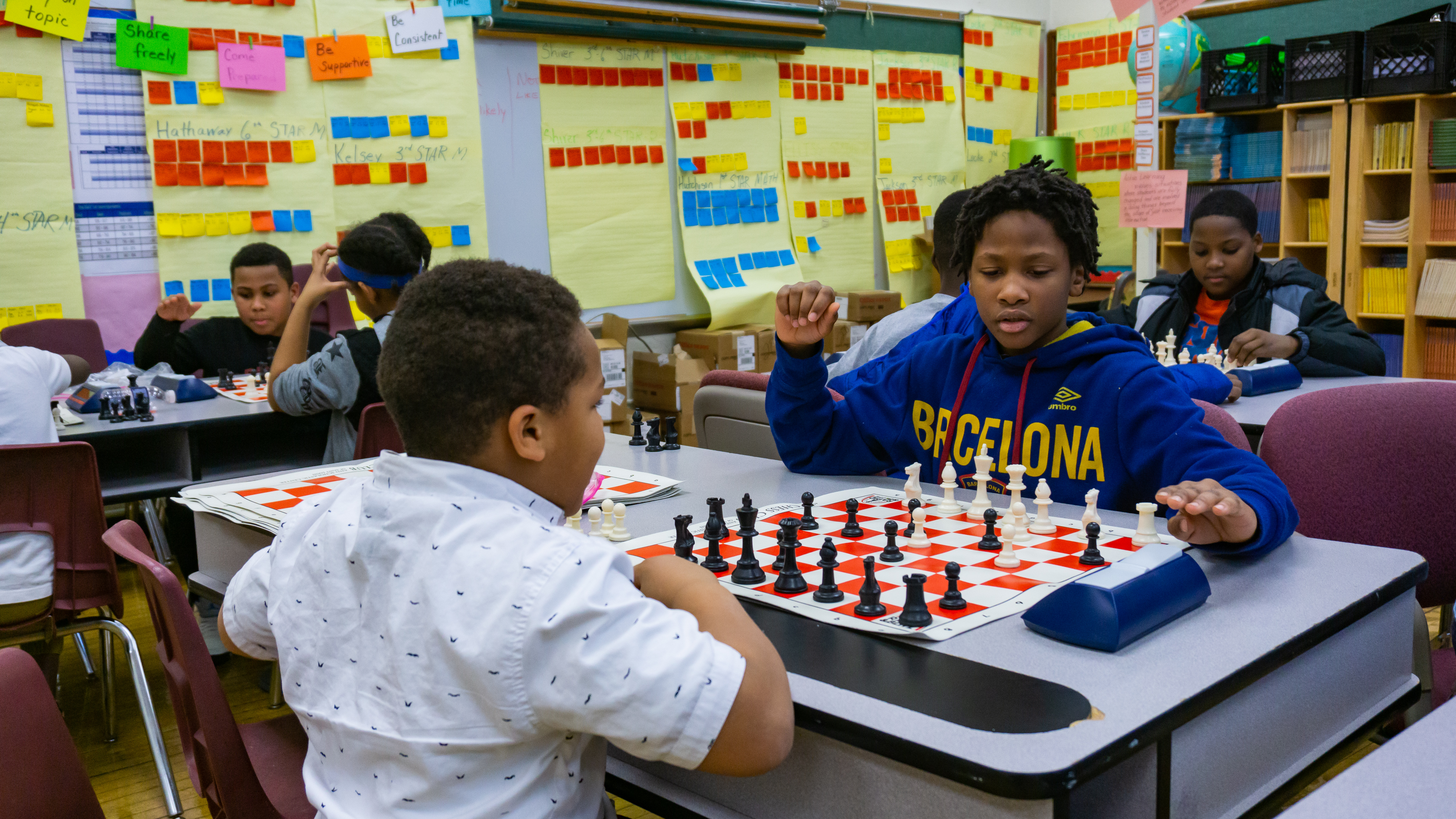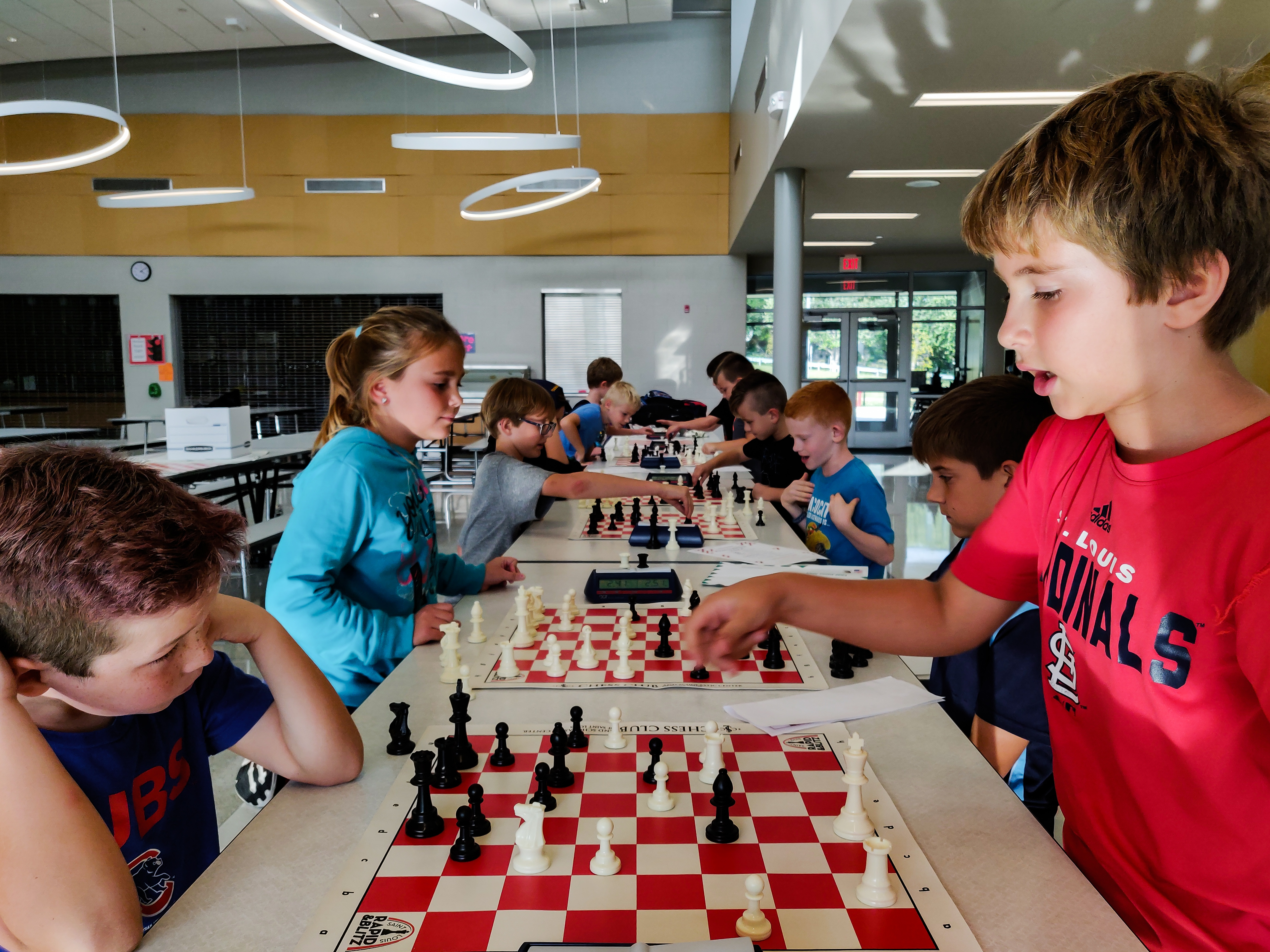
By Lawrence Hu, Scholastic Instructor
I’m not quite sure exactly how many lessons I’ve given on how the rook moves, what fork is, or how to properly hit the clock when you’ve made a move – it’s too many to count. Being a teacher, time kind of flows in a different way in my schools, almost like each classroom is a time capsule. However, even as the semesters pass by, I will never forget my very first day teaching in front of a group of students.
My immersion into teaching chess began at a one-week summer camp at Carver Elementary School. I was barely even a part of the scholastics program, a fresh hire. Shadowing Jana Thomas, I was being shown the ropes: How do I give an effective lesson on the rules of chess? What does it mean to be a ‘good’ teacher? Can I or can I not wear shorts to work? All the questions a beginner would ask.
Starting day one, even being just a witness was a bit of a culture shock for me. Having grown up first in the suburbs across the river and then in St. Louis County, being in the city was a completely different experience. Everything seemed older, closer together, and more serious. Compared to another class I was watching in Chesterfield, it seemed like such a different culture.
After shadowing for several classes, Jana suddenly handed me the reins, “do you want to teach a class?” Of course I couldn’t say no, even though I wanted to, so I accepted. Being a teacher has not just been, well, a strictly teaching experience.

Being as young as I am (20), I’ve only ever been on one side of the metaphorical desk or podium. Switching over to the role model in the educational realm was such a new experience that I was beside myself when I tried teaching my first lesson. Every stutter, “um”, and lesson point that I had forgotten was an excruciating silence. However, after a couple of pep talks and some guidance from the veterans, I found myself slipping into the flow of things rather quickly. Instead of frantically flipping through a list of things that I needed to teach, I could just ask the class what they knew and go from there. Rowdy students didn’t raise my blood pressure quite so much and I learned to work with the various personalities of each room. I became one with the students.
Beyond the “how do you effectively teach?” question, my last year of scholastics instruction have been eye opening. In an article about lessons, I really don’t have a specific list, but rather a big idea that I’ve learned to embrace throughout every school: compassion goes a long way. I might frequently look back on my elementary and middle school days and cringe, but it’s easy to forget that life was essentially a different world back then. Pretty much everything you knew was what your parents allowed you to do or, rather unfortunately, what your parents made you do.
There’s a lot more happening to kids than meets the eye. Working at Gateway Middle School and keeping in contact with the coordinator has taught me that life away from home might be causing behavioral symptoms at school, and each student might need different degrees of patience. At Monroe Elementary School, every class begins with a handshake and “what’s up? How’s it going?” letting students know that I care and that I’m on their side seems to foster this cooperative synergy that allows for a maximum amount of teaching and enjoyment. Uninterested students might not be in class because they want to, so it’s only going to be an uphill battle until you work with them to find where they can mesh with the material being taught. In most of my classes, if I can help it, those that answer “no” to “do you want to be here?” aren’t in my classroom. L’Ouverture AESM, a fairly recent addition to the scholastics program, is a huge class of close to 30 with many coming and going as the semester progresses, but I can handle it because everyone there wants to learn.

Part of this is, when in doubt, ask. Whether it’s about a class cancellation or on certain aspects of being a better educator, the cliché of “communication is everything” especially matters when it comes to the learning and developmental environment. A simple “are you doing okay?” to a student seemingly struggling might go a long way. The simple exchange of ideas and strategies is such a symbolic motif in chess, so why not use it everywhere? The K-8 world can be such a daunting and terrifying experience. It seems like everyone everywhere has an expectation for you and sometimes it’s easy to lose yourself in it. It was once in a blue moon that I would get asked, “what do you want?” and thus, I get to use this experience as that kind of olive branch to my students.
In the world of chess, it seems like choices that you get to make as an individual in the game are limitless, only bound by a set of rules. Being granted both that set of freedoms and responsibilities must be breath of fresh air. And, in the same way, chess has taught me the same.



